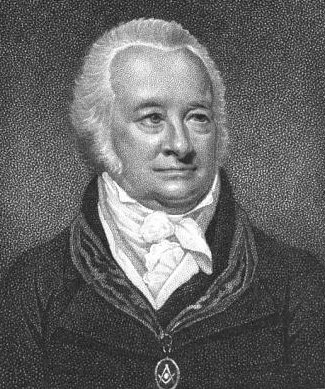
Born in Edinburgh on 7th August 1742, his father having supported the losing side at the 1745 Jacobean rebellion when Charles Stuart strived in vain to regain the British throne during the War of the Austrian Succession, whilst the British Army was fighting in mainland Europe watched his father deteriorate as he became depressed and unwell. His father died and Preston continued his education under the guidance of his now Legal Guardian Thomas Ruddiman who later found Preston work as an editor in London with Ruddiman’s brother.
Shortly after Preston’s arrival in London in 1760, a group of Edinburgh Freemasons living in there decided to form themselves into a lodge. As they then recognised the jurisdiction of the Antients’ Grand Lodge in the capital, the Grand Lodge of Scotland felt unable to grant them a constitution. They were accordingly constituted as Lodge no. 111 at the “White Hart” in the Strand on 20th April 1763. It may have been at this meeting that Preston became their second initiate.
Unhappy with the status of the relatively new Grand Lodge of which they found themselves a part, Preston and some others began attending a lodge attached to the original Grand Lodge of England and persuaded their brethren to change allegiance. Accordingly, on 15th November 1764, Lodge no 111 of the Antients became Caledonian Lodge no 325 (later 134), under a constitution which was just starting to be known as the “Moderns”. That lodge later held its meetings at the Great Eastern (now Andaz) Hotel on Liverpool Street in London. The shift of allegiance occasioned some vitriolic correspondence between Caledonian Lodge and their former Grand Lodge. Caledonian Lodge then became the major component in the first Grand Chapter of Royal Arch Masonry.
Preston soon began an extensive program of masonic research. Interviewing where he could and entering into an extensive correspondence with Freemasons in Britain and overseas, he built a vast storehouse of masonic knowledge, which he applied initially to explaining and organising the lectures attached to the three degrees of Freemasonry.
He met with friends once or twice a week to test and refine his presentation and on 21st May 1772 he organised a Gala at the Crown and Anchor in the Strand at his own considerable expense, to introduce the Grand Officers and other prominent masons to his system. The success of his oration on that day led to the publication, later that year, of his Illustrations of Masonry, which ran to twelve English editions during his lifetime, as well as being translated into other languages.
In 1774 he organised his material into lecture courses, delivered by him at the Mitre Tavern, Fleet Street. There were twelve lectures per degree, at one guinea per degree.
Present at the Gala were two members of the Lodge of Antiquity (once, known as the Goose and Gridiron, a founder of the Grand Lodge). John Bottomley was then the Master and John Noorthouck a colleague of Preston at Strahan’s printing firm. Antiquity was suffering from declining membership and these two men conceived the idea of reviving their lodge by recruiting Preston. He was elected a member, in absentia, on 1st June 1774. On his first attendance as a member, a fortnight later, he was elected Master of the lodge. The lodge accordingly flourished, which somehow displeased Bro Noorthouck. He complained that the younger masons who now flocked to the lodge were all Preston’s creatures, which had enabled him to stay in the chair for three and a half years.
During this period, commencing in 1769, Preston became the Assistant Grand Secretary, and “Printer to the Society”. This gave him access to material which he subsequently used in his “Illustrations of Masonry”. It also gave him the opportunity to attempt to drive a wedge between the Antients and the Grand Lodge of Scotland, by challenging the basis on which the younger Grand Lodge was formed. The attempt failed, and only served to widen the division between the two Grand Lodges.
Split from Grand Lodge
On 27th December 1777, some members of the Lodge of Antiquity, including Preston, returned from church wearing their masonic regalia. This amounted to little more than crossing the road. Certain of the original members of Antiquity who were not present (and who included the two men who had persuaded Preston to join Antiquity) chose to report the incident to Grand Lodge as a proscribed Masonic procession. Instead of playing down the occasion, Preston chose to defend his and his brethren’s action by emphasising the seniority of his own lodge. As the Goose and Gridiron, Antiquity had been one of the founders of Grand Lodge. Preston argued that his lodge had only subscribed to the original constitutions and subsequent rulings did not apply to them. After due process, Preston and his supporters were expelled in 1779. This divided the Lodge of Antiquity. The longer standing members stayed with the Moderns. The rest of the lodge allied itself with the “Grand Lodge of All England at York”, becoming for the period of their separation, the “Grand Lodge of All England South of the River Trent”, warranting at least two lodges in its own right. In May 1789 the dispute was resolved, Preston, after an apology, was welcomed back to his Masonic Honours at a dinner, and the two-halves of the Lodge of Antiquity were re-united in 1790.
![]()
